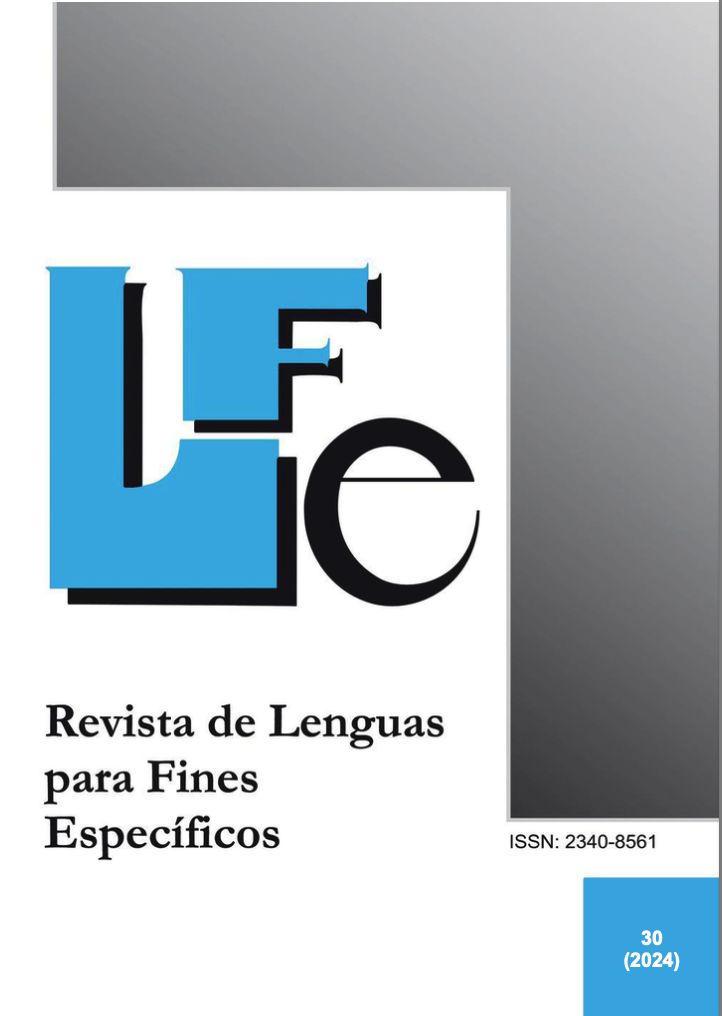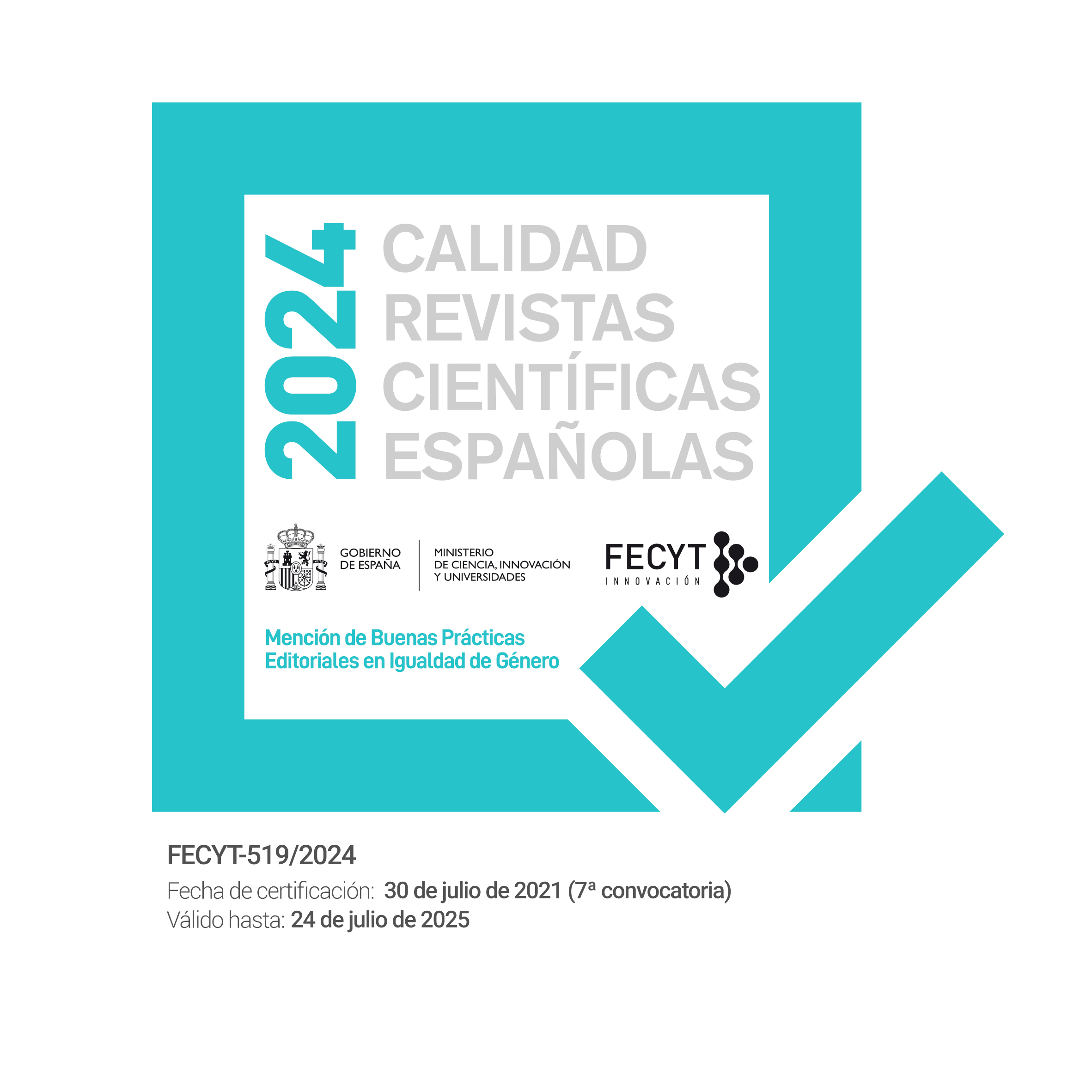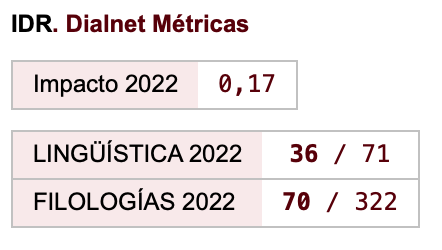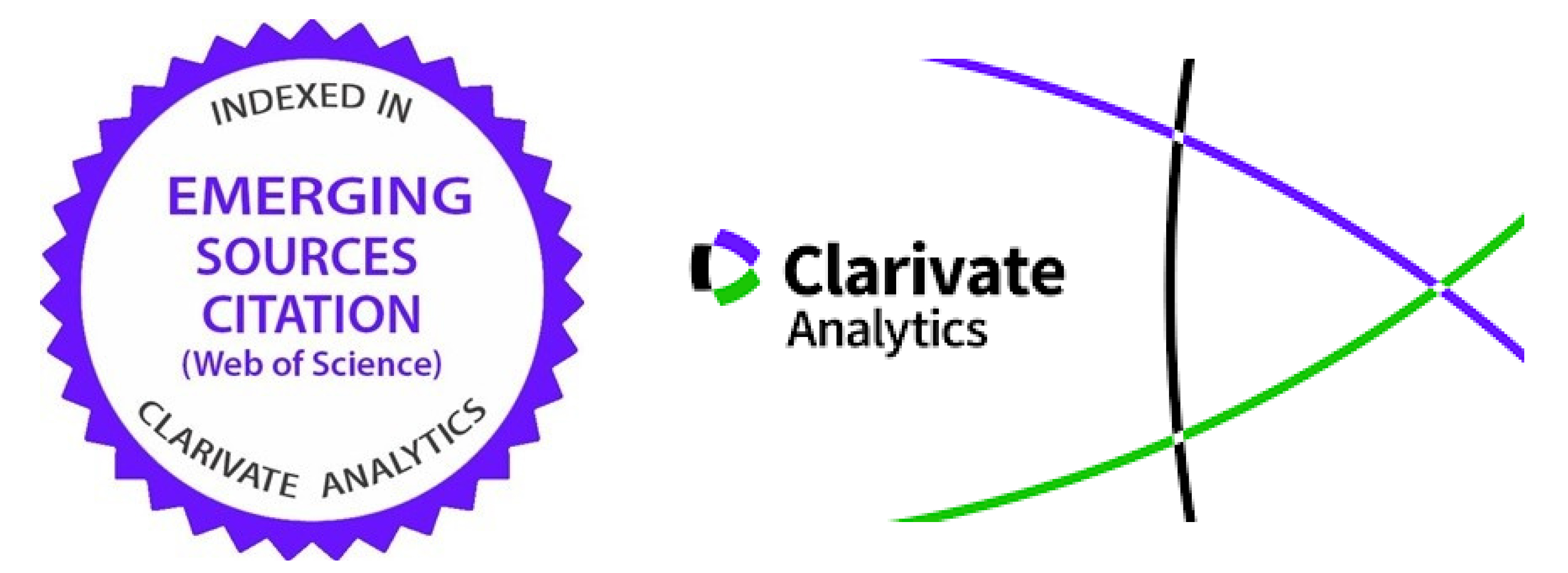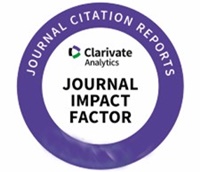The processing of nominal and pronominal anaphoric encapsulation in L2 Spanish speakers: an experimental study with eyetracking.
DOI:
https://doi.org/10.20420/rlfe/2024.697Keywords:
anaphoric encapsulation, information processing, eyetracking, spanish L2Abstract
Encapsulation is a discursive anaphora, since a neuter pronoun or a nominal syntagm is used to refer to textual elements already introduced in the discourse, but the reference is not established with a simple linguistic unit, but with a broader textual fragment. While a neutral pronoun such as spanish ello has an essentially procedural meaning and provides the reader only with the instruction to search the preceding discourse for a sentence construction that serves as a referent, the nominal encapsulator synthesizes the referent, recategorizes it, and involves a reification of an abstract entity. Anaphoric encapsulation is a discursive operation employed in highly planned texts typical of various specialty languages (academic, scientific, political, etc.). An eyetracking reading experiment conducted with 44 L2 Spanish speakers shows that non-native speakers apply different information extraction strategies depending on whether the encapsulation is established by means of a nominal or a pronominal element.Downloads
References
Álvarez de Mon y Rego, I. (2001). Encapsulation and prospection in written scientific English. Estudios Ingleses de la Universidad Complutense, 9, 81-101.
Arunachalam, S. (2013). Experimental Methods for Linguists. Language and Linguistics, 7(4), 221-232. https://doi.org/10.1111/lnc3.12021
Borreguero, M. (2006). Naturaleza y función de los encapsuladores en los textos informativamente densos (la noticia periodística). Cuadernos de Filología Italiana, 13, 73-95.
Borreguero, M. (2018). Los encapsuladores anafóricos: Una propuesta de clasificación. Caplletra Revista Internacional de Filologia, 64, 179-203. https://doi.org/10.7203/Caplletra.64.11380
Clifton, C., Staub, A. & Rayner, K. (2007). Eye movements in reading words and sentences. En R. van Gompel, M. Fischer, W. Murray & R. Hill (Eds.), Eye movements: A window on mind and brain (pp. 341-371). Elsevier.
Conklin, K., Pellicer-Sánchez, A. & Carrol, G. (2018). Eye-Tracking A Guide for Applied Linguistics Research. Cambridge University Press.
Damm, L. (2014). The interpretation of encapsulating anaphors in Spanish and their functions. Folia Linguistica, 48(1), 37-49. https://doi.org/10.1515/flin.2014.002
Duque, E. (2020). Neuter pronoun ello and discourse verbs in Spanish. Journal of Pragmatics, 155, 273-285. https://doi.org/10.1016/j.pragma.2019.09.006
Fuentes, C. (2017). Macrosintaxis y lingüística pragmática. Círculo de lingüística aplicada a la comunicación, 71, 5-34. https://doi.org/10.5209/CLAC.57301
García Negroni, M. M., Hall, B. & Marín, M. (2005). Ambigüedad, abstracción y polifonía del discurso académico: Interpretación de las nominalizaciones. Signos. Estudios de Lingüística, 38(57), 49-60.
González, R. (2008). Las nominalizaciones como estrategia de manipulación informativa en la noticia periodística: El caso de la anáfora conceptual. En I. Olza, M. Casado y R. González (Eds.), Actas del XXXVII Simposio Internacional de la Sociedad Española de Lingüística (SEL) (pp. 247-259). Universidad de Navarra.
Halliday, M. & Hasan, R. (1976). Cohesion in English. Longman Group.
Holmqvist, K., Nyström, M., Andersson, R., Dewhurst, R., Halszka, J. & van de Weijer, J. (2011). Eye Tracking: A Comprehensive Guide to Methods and Measures. Oxford University Press.
Izquierdo, D. & González, R. (2013). Encapsulación y etiquetas discursivas en el discurso parlamentario: Función argumentativa a partir de un corpus paralelo. Oralia, 16, 185-219.
Jegerski, J. (2014). Self-paced reading. En J. Jegerski & B. VanPatten (Eds.), Research methods in second language psycholinguistics (pp. 20-49). Routledge.
Just, M. & Carpenter, P. (1980). A theory of reading: From eye fixations to comprehension. Psychological Revies, 87(4), 329-354. https://doi.org/10.1037/0033-295X.87.4.329
Keating, G. & Jegerski, J. (2015). Experimental Designs in Sentence Processing Research. A Methodological Review and User’s Guide. Studies in Second Language Acquisition, 37(1), 1-32.
Leonetti, M. (2020). Referencia nominal y anáfora discursiva. En M. V. Escandell, J. Amenós, A. Ahern (Eds.), Pragmática (pp. 145-165). AKAL.
Leonetti, M. & Escandell, M. V. (2015). La interfaz sintaxis-pragmática. En A. Gallego (Ed.), Perspectivas de sintaxis formal. AKAL.
Levinson, S. (1983). Pragmatics. Cambridge University Press.
López Samaniego, A. (2011). La categorización de entidades del discurso en la escritura profesional. Las etiquetas discursivas como mecanismo de cohesión léxica. Universidad de Barcelona.
López Samaniego, A. (2015). Etiquetas discursivas, hiperónimos y encapsuladores: Una propuesta de clasificación de las relaciones de cohesión referencial. Rilce: Revista de Filología Hispánica, 31(2), 435-462.
López Samaniego, A. (2017). Deixis textual y discursiva en el discurso científico-académico oral y escrito. CHIMERA Revista de Corpus de Lenguas Romances y Estudios Lingüísticos, 4(1), 61-88.
López Samaniego, A. (2018). La encapsulación nominal en el discurso académico-científico oral y escrito: Patrones de aparición. Caplletra Revista Internacional de Filologia, 64, 129-152. https://doi.org/10.7203/caplletra.64.11369
López Samaniego, A. & Taranilla, R. (2014). Mecanismos de cohesión (I). El mantenimiento referencial. En E. Montolío (Dir.), Manual de escritura académica y profesional (Vol. I) (pp. 377-442). Ariel.
Loureda, Ó., Recio, I., Cruz, A. & Nadal, L. (2020). Pragmática experimental. En M. V. Escandell, J. Amenós Pons, A. K. Ahern (Coords.), Pragmática (pp. 358-383). AKAL. https://doi.org/10.1017/9781108233279
Marsden, E., Thomson, S. & Plonky, L. (2018). A methodological synthesis of self-paced reading in second language research. Applied Psycholinguistics, 39(5), 861-904. https://doi.org/DOI: https://doi.org/10.1017/S0142716418000036
Mederos, H. (1988). Procedimientos de cohesión en el español actual. Cabildo Insular.
Méndez, E. (2003). Nominalización y tipo de texto. En J. L. Girón Alconchel, S. Iglesias Recuero, F. J. Herrero Ruiz de Loizaga, A. Narbona Jiménez (Coords.), Estudios ofrecidos al profesor José Jesús de Bustos Tovar (pp. 1015-1032). Universidad Complutense de Madrid.
Montolío, E. (2016). Construcciones conectivas que encapsulan. [A pesar de + SN] y la escritura experta. Cuadernos AISPI, 2/2013. https://doi.org/10.14672/2.2013.1066
Nadal, L. (2019). Lingüística experimental y contraargumentación: Un estudio del conector sin embargo en español. Peter Lang.
Parodi, G. & Burdiles, G. (2016). Encapsulación y tipos de coherencia referencial y relacional: El pronombre ello como mecanismo encapsulador en el discurso escrito de la economía. Onomázein, 38, 107-129.
Parodi, G. & Burdiles, G. (2019). Los pronombres neutros ‘esto’, ‘eso’ y ‘aquello’ como mecanismos encapsuladores en el discurso de la economía: Coherencia referencial y relacional. Spanish in context, 16(1), 104-127. https://doi.org/10.1075/sic.00028.par
Parodi, G., Julio, C., Nadal, L., Burdiles, G. & Cruz, A. (2018). Always look back: Eye movements as a reflection of anaphoric encapsulation in Spanish while reading the neuter pronoun ello. Journal of Pragmatics, 132, 47-58. https://doi.org/10.1016/j.pragma.2018.05.008
Parodi, G., Julio, C., Nadal, L., Burdiles, G., & Cruz, A. (2019). Stepping back to look ahead: Neuter encapsulation and referent extension in counter-argumentative and causal relations in Spanish. Language and Cognition, 11(3), 431-454. https://doi.org/10.1017/langcog.2019.24
Pérez Álvarez, B. (2014). Funciones discursivas de esto, eso y aquello en corpus oral. Anuario de Letras. Lingüística y Filología, 2(1), 103-140.
Pickering, M., Traxler, M. & Crocker, M. (2000). Ambiguity Resolution in Sentence Processing: Evidence against Frequency-Based Accounts. 43(3), 447-475. https://doi.org/10.1006/jmla.2000.2708
Pons, S. (2004). Conceptos y aplicaciones de la Teoría de la Relevancia. Arco Libros.
Rayner, K. (1998). Eye Movements in Reading and Information Processing: 20 Years of Research. Psychological Bulletin, 124(3), 372-422. https://doi.org/10.1037/0033-2909.124.3.372
Rayner, K. (2009). Eye movements and attention in reading, scene perception, and visual search. The Quarterly Journal of Experimental Psychology, 62(8), 1457-1506. https://doi.org/10.1080/17470210902816461
Richardson, D. & Spivey, M. (2008). Eye-Tracking: Characteristics and Methods. En Wnek, G. & Bowlin, G. (Eds.), Encyclopedia of Biomaterials and Biomedical Engineering (p. capítulo 5). CRC Print. https://doi.org/10.1201/9780429154065
Schmid, H.-J. (1997). Constant and ephemeral hypostatization: Thing, problem and other «shell nouns». En Carol, Bernhard (Ed.), Prceedings of the 16th International Congress of Linguists (París) (pp. 20-25). Elsevier.
Schmid, H.-J. (2001). «Presupposition can be a bluff»: How abstract nouns can be used as presupposition triggers. Journal of Pragmatics, 33(10), 1529-1552. https://doi.org/10.1016/S0378-2166(01)00027-3
van Dijk, T. (2003). La ciencia del texto. Paidós.
Winter, B. (2020). Statistics for Linguists: An Introduction Using R. Routledge.
Published
How to Cite
Issue
Section
License
Copyright (c) 2024 Laura Nadal

This work is licensed under a Creative Commons Attribution-NonCommercial-NoDerivatives 4.0 International License.
Authors who publish with this journal agree to the following terms:
- Authors retain copyright and grant the journal right of first publication with the work simultaneously licensed under a Creative Commons Attribution License that allows others to share the work with an acknowledgement of the work's authorship and initial publication in this journal.
- Authors are able to enter into separate, additional contractual arrangements for the non-exclusive distribution of the journal's published version of the work (e.g., post it to an institutional repository or publish it in a book), with an acknowledgement of its initial publication in this journal.
- Authors are permitted and encouraged to post their work online (e.g., in institutional repositories or on their website) prior to and during the submission process, as it can lead to productive exchanges, as well as earlier and greater citation of published work (See The Effect of Open Access).

Revista de Lenguas para fines específicos is licensed under a Creative Commons Reconocimiento-NoComercial-SinObraDerivada 4.0 Internacional License.

